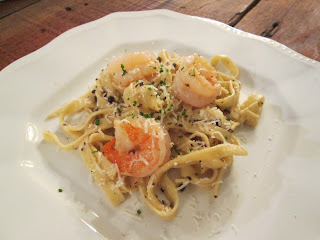Gnudi hail from Tuscany and are like melt-in-the-mouth pillows. In many ways they are like gnocchi, though they are made out of cheese rather than potato. Gnudi in Italian means "naked," because they are like cheese filled ravioli stripped of its pasta wrapper.
 Although gnudi would ordinarily not find its way on any health-conscious menu, this particular recipe has been adapted from Rocco Dispirito's reduced calories Italian cookbook. However, I cannot claim all of the calorie slashing that he does, because I am convinced that a great ricotta gnudi depends upon a creamy ricotta, and creamy cannot be achieved with a fat-free or reduced-fat ricotta. What can be said of this recipe is that it still significantly reduces the flour calories of a traditional recipe with the use of a little cornstarch and egg white powder. Egg white powder can be found in the heath food department of your local grocery store. Sure, it is a little expensive per volume, but it greatly reduces the amount of caloric flour and therefore provides a more healthy option for this wonderfully rich dish.
Although gnudi would ordinarily not find its way on any health-conscious menu, this particular recipe has been adapted from Rocco Dispirito's reduced calories Italian cookbook. However, I cannot claim all of the calorie slashing that he does, because I am convinced that a great ricotta gnudi depends upon a creamy ricotta, and creamy cannot be achieved with a fat-free or reduced-fat ricotta. What can be said of this recipe is that it still significantly reduces the flour calories of a traditional recipe with the use of a little cornstarch and egg white powder. Egg white powder can be found in the heath food department of your local grocery store. Sure, it is a little expensive per volume, but it greatly reduces the amount of caloric flour and therefore provides a more healthy option for this wonderfully rich dish.Servings: 4 (20 gnudi)
Time: 50 minutes (Note: prepare the ricotta in advance)
Marinara Sauce
1-3/4 cups whole milk ricotta, strained
for 1 hour in advance (or better, make your own Homemade Ricotta)
2 tablespoons flour (or Cup 4 Cup gluten free flour)
3/4 ounce Parmigiano-Reggiano, grated
1/2 cup roughly chopped basil
A pinch of ground nutmeg
4 tablespoons egg white powder
1/4 cup cornstarch
Salt and fresh ground pepper to taste
1. IN ADVANCE, you may either prepare Homemade Ricotta, letting it strain for 2 hours, or if you prefer you may strain the store bought ricotta for at least 1 hour.
2. In a sauce pan, begin to heat the marinara. Likewise, bring 4 quarts of water and 2 tablespoons of kosher or sea salt to boil.
 3. In a bowl, combine the ricotta, flour, Parmigiano-Reggiano, basil, flour, nutmeg, and 1 tablespoon of the egg white powder. Mix thoroughly. Season with salt and pepper to taste.
3. In a bowl, combine the ricotta, flour, Parmigiano-Reggiano, basil, flour, nutmeg, and 1 tablespoon of the egg white powder. Mix thoroughly. Season with salt and pepper to taste.4. Scoop out 20 generous tablespoons of the mixture and place them on a baking sheet or platter. At this stage, its consistency will be similar to cookie dough. Place the platter or baking sheet in the freezer for 10 minutes in order to harden slightly. This will enable you to finish shaping and coating them more easily.
 5. Place the remaining 3 tablespoons of egg white powder in a bowl. In the palm of your hand, roll each gnudi into nicely formed balls. Then, thoroughly coat each ball in the egg white powder.
5. Place the remaining 3 tablespoons of egg white powder in a bowl. In the palm of your hand, roll each gnudi into nicely formed balls. Then, thoroughly coat each ball in the egg white powder.6. Place the cornstarch in a separate bowl. Give each ball an additional coating of cornstarch until completely covered.
7. Without letting the balls touch each other, drop them into the rapidly boiling water. Cook for precisely 2 minutes.
"The reason traditional gnudi don't fall apart in the boiling water is because they're dried uncovered overnight and a natural flour wrapper forms. Since I couldn't use highly caloric flour, I had to devise a way to envelop the cheese without adding too many calories. The combination of egg white powder and cornstarch accomplished just that. The exercise of swapping out calories often produces a result where flavors pop even more than in the original, as is the case here." – Rocco Dispirito
8. After 2 minutes, gently remove the gnudi from the water. Serve with marinara and some additional shredded Parmigiano. Enjoy!
Recommended Wine
Because gnudi hails from Tuscany, a nice Tuscan Chianti might be in order. 2007 was a good year for Chianti. I would recommend the 2007 La Castellina Chianti Classico. This wine has strong hints of cherry and a nice acidity that contrasts with the richness of the gnudi.












































